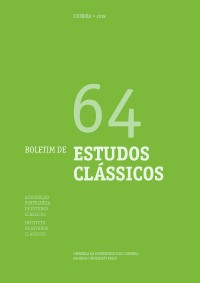Please use this identifier to cite or link to this item:
https://hdl.handle.net/10316.2/47828| DC Field | Value | Language |
|---|---|---|
| dc.contributor.author | D'Encarnação, José | - |
| dc.date.accessioned | 2020-01-22T12:58:08Z | |
| dc.date.accessioned | 2020-09-21T05:31:08Z | - |
| dc.date.available | 2020-01-22T12:58:08Z | |
| dc.date.available | 2020-09-21T05:31:08Z | - |
| dc.date.issued | 2019 | - |
| dc.identifier.issn | 0872-2110 | - |
| dc.identifier.issn | 2183-7260 (PDF) | - |
| dc.identifier.uri | https://hdl.handle.net/10316.2/47828 | - |
| dc.description.abstract | Prosseguindo a série que visa mostrar como, a partir de um monumento epigráfico, se pode aprender um Latim vivo, faz-se brevíssima síntese histórica acerca do sítio arqueológico de Tróia, donde proveio a placa funerária romana a estudar. Esse estudo permitiu avançar uma proposta de restituição do texto incompleto. Por outro lado, a singularidade da decoração deu azo a que se reflectisse sobre a possibilidade de vir a conhecer-se o seu real significado. | por |
| dc.description.abstract | This series has as objective to show how the epigraphic monuments are interesting vehicle to learn Latin. In this paper, the study of a funerary epitaph from Tróia (Grândola, conventus Pacensis, Lusitania) documents the practice of the epigraphist to reconstitute an incomplete text and, in the other side, the study of the real significance of his singular decoration. | eng |
| dc.language.iso | por | - |
| dc.publisher | Imprensa da Universidade de Coimbra | - |
| dc.rights | open access | - |
| dc.subject | IRCP 223 | eng |
| dc.subject | Tróia | eng |
| dc.subject | Roman funerary epigraphy | eng |
| dc.subject | funerary decoration | eng |
| dc.subject | professions | eng |
| dc.subject | IRCP 223 | por |
| dc.subject | Tróia | por |
| dc.subject | epigrafia funerária | por |
| dc.subject | ecoração funerária | por |
| dc.subject | ofícios | por |
| dc.title | A epígrafe latina como elemento didáctico (XXXVI): uma singular placa funerária de Tróia (Grândola) | por |
| dc.title.alternative | The latin epigraphy as a didactic element (XXXVI): a Roman singular epigraphic monument of Tróia (Grândola - Portugal) | por |
| dc.type | article | - |
| uc.publication.collection | Boletim de Estudos Clássicos vol. 64 | - |
| uc.publication.firstPage | 85 | - |
| uc.publication.lastPage | 96 | - |
| uc.publication.location | Coimbra | - |
| uc.publication.journalTitle | Boletim de Estudos Clássicos | - |
| uc.publication.volume | 64 | por |
| dc.identifier.doi | 10.14195/2183-7260_64_4 | - |
| uc.publication.section | Latim | - |
| uc.publication.orderno | 5 | - |
| uc.publication.area | Artes e Humanidades | - |
| uc.publication.manifest | https://dl.uc.pt/json/iiif/10316.2/47828/229433/manifest?manifest=/json/iiif/10316.2/47828/229433/manifest | - |
| uc.publication.thumbnail | https://dl.uc.pt/retrieve/11444082 | - |
| item.grantfulltext | open | - |
| item.fulltext | With Fulltext | - |
| Appears in Collections: | Boletim de Estudos Clássicos | |
Files in This Item:
| File | Description | Size | Format | |
|---|---|---|---|---|
| a_epigrafe_latina_como_elemento_didactico.pdf | 1.28 MB | Adobe PDF |  |
Items in DSpace are protected by copyright, with all rights reserved, unless otherwise indicated.
